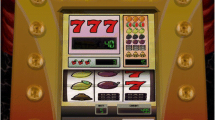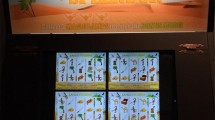Abstract
We present the results of a field study examining the effect of losses disguised as wins (LDWs) on subsequent slot machine gambler betting behavior. An LDW occurs when the amount won is less than the amount bet. Using non-experimental, individual transaction gambling data, we examine post LDW betting behavior in a panel of 42,669 gamblers and 17 million slot machine plays. The primary empirical findings include: (1) streaks of three LDWs greater than 75% of the original amount bet lead slot gamblers to increase the amount bet on the next spin; (2) streaks of three LDWs less than 25% of the original amount bet results in gamblers decreasing their bet size on the next spin; (3) slot machine gamblers play faster following streaks of three LDWs compared to losses. We interpret these behavioral findings of differing outcomes associated with small versus large LDWs as consistent with a cognitive dissonance effect (Festinger, 1957). Specifically, the disconnect between the amount “won” (actually lost) and the audio and video stimulus produced by the slot machine highlighting the LDW, produces a dissonance-related arousal that players seek to avoid or reduce leading to changes in betting behavior. Our results complement the experimental findings on LDWs and suggest that the size of the LDW matters in examining the impact on gambling behavior.



Similar content being viewed by others
Data Availability
The dataset used for the current study is not publicly available as it contains proprietary information that the authors acquired through private company under the condition of anonymity.
Notes
Most modern slot machines are electronic video game like devices and there are no actual mechanical reels to spin. Nevertheless, we will use the term “spin” to refer to a single trial of a slot machine transaction (i.e., bet/play/outcome).
We also ran the regressions including all break-even outcomes and the results are similar to those reported here with no meaningful differences. These results are available upon request.
This is calculated by taking the partial derivative of the quadratic equation that is estimated and setting it to zero in order to solve for the minimum value of LDW. Here, that is -0.00089 + 2*.000021LDW = 0. Solving gives an LDW of 21.19%.
This represents 9% of the median time between sessions of 149 s, but only 0.8% of the mean time of 1,644 s.
References
Anselme, P., & Robinson, M. J. (2020). From sign-tracking to attentional bias: implications for gambling and substance use disorders. Progress in Neuro-Psychopharmacology and Biological Psychiatry, 99, 109861.
Barton, K. R., Yazdani, Y., Ayer, N., Kalvapalle, S., Brown, S., Stapleton, J., & Harrigan, K. A. (2017). The effect of losses disguised as wins and near misses in electronic gaming machines: a systematic review. Journal of Gambling Studies, 33(4), 1241–1260.
Coventry, K. R., & Hudson, J. (2001). Gender differences, physiological arousal and the role of winning in fruit machine gamblers. Addiction 2001; 96: 871–9.
Dixon, M. J., Harrigan, K. A., Sandhu, R., Collins, K., & Fugelsang, J. A. (2010). Losses disguised as wins in modern multi-line video slot machines. Addiction, 105(10), 1819–1824.
Dixon, M., Graydon, C., Harrigan, K., Wojtowicz, L., Sju, V., & Fugelsang, J. (2014). The allure of multi-line games in modern slot machines. Addiction, 109(11), 1920–1928. (Nov 2014).
Dixon, M. J., Collins, K., Harrigan, K. A., Graydon, C., & Fugelsang, J. A. (2015). Using sound to unmask losses disguised as wins in multiline slot machines. Journal of Gambling Studies, 31(1), 183–196.
Elliot, A. J., & Devine, P. G. (1994). On the motivational nature of cognitive dissonance: dissonance as psychological discomfort. Journal of personality and social psychology, 67(3), 382–394.
Festinger, L. (1957). A theory of cognitive dissonance. Stanford, CA: Stanford University Press.
Graydon, C., Dixon, M. J., Stange, M., & Fugelsang, J. A. (2019). Gambling despite financial loss—the role of losses disguised as wins in multi-line slots. Addiction, 114(1), 119–124.
Graydon, C., Dixon, M. J., Gutierrez, J., Stange, M., Larche, C. J., & Kruger, T. B. (2021). Do losses disguised as wins create a “sweet spot” for win overestimates in multiline slots play? Addictive Behaviors, 112, 106598.
Harmon-Jones, E., & Mills, J. (1999). An introduction to cognitive dissonance theory and an overview of current perspectives on the theory. In E. Harmon-Jones, & J. Mills (Eds.), Cognitive dissonance: progress on a pivotal theory in social psychology (pp. 3–21). Washington, DC: American Psychological Association.
Izuma, K., Matsumoto, M., Murayama, K., Samejima, K., Norihiro, S., & Matsumoto, K. (2013). Neural correlates of cognitive dissonance and decision conflict. Advances in cognitive neurodynamics (III) (pp. 623–628). Dordrecht: Springer.
Jensen, C., Dixon, M. J., Harrigan, K. A., Sheepy, E., Fugelsang, J. A., & Jarick, M. (2013). Misinterpreting ‘winning’ in multiline slot machine games. International Gambling Studies, 13(1), 112–126.
Leino, T., Torsheim, T., Pallesen, S., Blaszczynski, A., Sagoe, D., & Molde, H. (2016). An empirical real-world study of losses disguised as wins in electronic gaming machines. International Gambling Studies, 16(3), 470–480.
Livingstone, C., Woolley, R., Zazryn, T., Bakacs, L., & Shami, R. (2008). The relevance and role of gaming machine games and game features on the play of problem gamblers. Australian Institute for Primary Care and Ageing (LaTrobe).
Lole, L., Gonsalvez, C. J., Barry, R. J., & Blaszczynski, A. (2014). Problem gamblers are hyposensitive to wins: an analysis of skin conductance responses during actual gambling on electronic gaming machines. Psychophysiology, 51(6), 556–564.
Martinie, M. A., Olive, T., & Milland, L. (2010). Cognitive dissonance induced by writing a counterattitudinal essay facilitates performance on simple tasks but not on complex tasks that involve working memory. Journal of experimental social psychology, 46(4), 587–594.
Moodie, C., & Finnigan, F. (2005). A comparison of the autonomic arousal of frequent, infrequent and non-gamblers while playing fruit machines. Addiction, 100(Jan), 1.
Robinson, T. E., & Berridge, K. C. (1993). The neural basis of drug craving: an incentive-sensitization theory of addiction. Brain research reviews, 18(3), 247–291.
Salaghe, F., Sundali, J., Nichols, M. W., & Guerrero, F. (2020). An empirical investigation of wagering behavior in a large sample of slot machine gamblers. Journal of Economic Behavior & Organization, 169, 369–388.
Scarfe, M. L., Stange, M., & Dixon, M. J. (2021). Measuring Gamblers’ Behaviour to show that negative sounds can reveal the true nature of losses disguised as Wins in Multiline Slot Machines. Journal of Gambling Studies, 37(2), 403–425.
Templeton, J. A., Dixon, M. J., Harrigan, K. A., & Fugelsang, J. A. (2015). Upping the reinforcement rate by playing the maximum lines in multi-line slot machine play. Journal of Gambling Studies, 31(3), 949–964. https://doi.org/10.1007/s10899-014-9446-5.
Walker, M. (2004). The seductiveness of poker machines. Gambling Research: Journal of the National Association for Gambling Studies (Australia), 16(2), 52–66.
Williamson, A., & Walker, M. (2001). Strategies for solving the insoluble: Playing to win Queen of the Nile. Lessons of the Past, 202.
Author information
Authors and Affiliations
Corresponding author
Ethics declarations
Competing Interests
The authors have no competing interests to declare that are relevant to the content of this article.
Additional information
Publisher’s Note
Springer Nature remains neutral with regard to jurisdictional claims in published maps and institutional affiliations.
Rights and permissions
Springer Nature or its licensor (e.g. a society or other partner) holds exclusive rights to this article under a publishing agreement with the author(s) or other rightsholder(s); author self-archiving of the accepted manuscript version of this article is solely governed by the terms of such publishing agreement and applicable law.
About this article
Cite this article
Salaghe, F., Guerrero, F., Jones, D. et al. Behavioral Responses to Losses Disguised as Wins: A Field Study of Slot Machine Players. J Gambl Stud 39, 1155–1174 (2023). https://doi.org/10.1007/s10899-022-10184-w
Received:
Revised:
Accepted:
Published:
Issue Date:
DOI: https://doi.org/10.1007/s10899-022-10184-w




